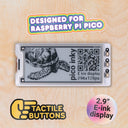Pico Inky Pack
by Pimoroni

A svelte 2.9" (296x128px) mono E Ink® display for Raspberry Pi Pico / Pico W.
Pico Inky Pack features the speedy 2.9" e-paper display that you can find on Badger 2040, coupled with three handy buttons for interfacing. Equip it to the back of your Pico or Pico W to give it a classy, readable display (and +1 to crispness). This screen leaves plenty of pins free on the Pico, so it's ideal for combining with other Packs, sensors or breakouts.
We're super hyped to try this screen with the shiny new Raspberry Pi Pico W and see what we can do with the new wireless connectivity. Can we make it display tweets or news headlines or live bus timetables or traffic updates? Perhaps we can hook it up to our home automation and use it as a little dashboard?
Your Pico will need to have pin headers soldered to it (with the pins pointing downwards) to attach to our add-on boards.
RP2040 x E Ink®
We're big fans of electronic paper at Pirate HQ - it makes for a lovely, crisp, high contrast display that's readable even in bright sunlight and it doesn't squirt unnecessary blue light into your environs like LCDs do. It's also ultra low power (EPD displays only consume power while they're refreshing), and the images on the display stick around for a really long time whilst the display is unpowered.
Using a RP2040 chip means we can drive the hardware in fun, experimental, low level ways. We've written custom drivers for the EPD display that prioritise low power consumption whilst enabling lightning fast refresh rates.
Features
- 2.9" black and white E Ink® display (296 x 128 pixels)
- Ultra wide viewing angles
- Ultra low power consumption
- Dot pitch - 0.227 x 0.226 mm
- 3 x tactile buttons
- Built in Captain Resetti (reset button!)
- Pre-soldered socket headers for attaching to Pico
- Compatible with Raspberry Pi Pico/Pico W.
- Fully assembled
- No soldering required (as long as your Pico has header pins attached).
- C/C++ and MicroPython libraries
- Schematic
A Raspberry Pi Pico / Pico W is not included so make sure to grab one!
Software
Our C++/MicroPython libraries are packed with nifty software tweaks to get the most out of this screen. You'll get best performance using C++, but if you're a beginner we'd recommend using our batteries included MicroPython build for ease of getting started.
- Download pirate-brand MicroPython
- Getting Started with Raspberry Pi Pico
- PicoGraphics function reference
-
MicroPython examples
To run the wireless examples, you'll need to have network_manager.py and WIFI_CONFIG.py saved to your Pico W. Open up WIFI_CONFIG.py in Thonny to add your wifi details (and save it when you're done).
You'll also need to install the micropython-urllib.urequest library using Thonny's 'Tools' > 'Manage Packages'.
Notes
- Measurements: 87 x 38.7 x 9.7 mm (L x W x H, approx)
- This pack is wideboi. Even though it's bigger than our other Pico Packs, Inky Pack will still work with Pico Omnibus or Pico Decker, if you want to use more than one Pico Pack at once. Please note though that if you plug it into a Pico Decker, it will overhang the addon slots next to it.
About Raspberry Pi Pico
Raspberry Pi Pico is a flexible, low cost microcontroller development board from the folks at Raspberry Pi, based on their very own chip - the RP2040. It's easily programmable over USB with C/C++ or MicroPython, and ideal for using in all sorts of physical computing projects, devices and inventions - we're so excited to see what you make with it! As of June 2022, you can also buy a Raspberry Pi Pico W which has wireless connectivity.
We've called our Pico-sized add-ons packs, as they're designed to attach to the back of your Pico as if it were wearing a very stylish back pack (or a miniature jet pack, if you prefer). We've also got Pico bases (larger add-on boards with a space to mount your Pico on top) and some other boards that let you do interesting hackerly things like using multiple packs at once - click here to view them all!
We no longer stock this product
It's sad to say goodbye but sometimes we have to retire products to make way for new things.
Need a large quantity or a customised version? We may be able to help! Contact wholesale@pimoroni.com to discuss a custom build.
Shop with confidence – we've been serving the hobbyist electronics, Maker, and retro gaming communities since 2012.
- Satisfaction or refund guarantee
- Worldwide shipping via mail or courier
- 57,000+ customer reviews
- Secure website and payments

